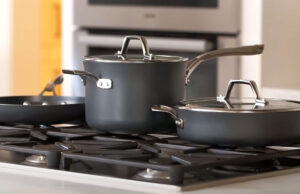As an Amazon Associate, I earn from qualifying purchases at no extra cost to you.
How to Test Dishwasher Water Inlet Valve Like a Pro at Home
Last week, my dishwasher stopped filling with water right before a big dinner party. I stood there, staring at it, wondering if it was broken for good. Turns out, the issue was something small—the water inlet valve. If you’ve ever been stuck like that, you know how frustrating it feels. In this article, we’ll walk through exactly how to test dishwasher water inlet valve in simple steps.
Turn off power and water, locate the valve, inspect for dirt or damage, check electrical continuity with a multimeter, clean or replace if faulty, and reconnect everything properly before testing again. Each step ensures your dishwasher’s water flow works correctly without leaks or electrical issues. Follow carefully to avoid mistakes and extend the life of your appliance.
Unplug and Shut Off the Water Supply
The first thing to do before touching anything is to make sure your dishwasher is safe to work on. Unplug the power cord from the wall outlet, even if you think the switch is off. Sometimes power still runs through, and it’s not worth the risk. Then, turn off the water supply valve under the sink to stop water from flowing.
It’s amazing how often people forget this simple step and end up with water all over the floor. Take a minute to double-check both power and water are completely off. You can even test by running the dishwasher—if it doesn’t start or fill, you’re good to go. This precaution saves both your safety and your floor from flooding.
Once the power and water are off, you can slide the dishwasher out from the counter carefully. Be gentle with the hoses and cords; they can be fragile. Lay a towel on the floor just in case there’s leftover water inside. It’s always better to prevent mess before it starts, right?
Finally, gather your tools before you begin—usually just a screwdriver, pliers, and a multimeter. Having everything ready avoids running back and forth mid-task. It keeps things smooth and stress-free, especially if you’re doing this alone at night or on a weekend.
- Unplug the dishwasher completely
- Turn off the water supply valve
- Slide out the appliance carefully
- Keep tools and towels ready
Locate the Water Inlet Valve
Once everything’s powered off, it’s time to find where the water inlet valve sits. Usually, it’s at the bottom of the dishwasher, behind the lower front access panel. You might need to remove a couple of screws to get to it. It’s a small part with a hose attached—don’t worry, you’ll recognize it once you see it.
Think of it like a gatekeeper—it controls how much water enters your dishwasher. If it’s stuck or clogged, your machine either won’t fill or could overfill. A good flashlight helps here since the area can be dark. You’ll notice wires connected to it too; those send signals to open or close the valve.
If your dishwasher has been running slower or making odd filling noises lately, that’s often a clue the valve isn’t working right. You might even spot mineral buildup or corrosion near it. In hard-water areas, that’s super common and can block water flow over time.
Take photos before disconnecting anything. Trust me, it’ll make reassembly a lot easier later. Many people skip this, only to forget where each wire goes. A quick snapshot saves the guesswork and frustration when putting everything back together.
- Remove bottom panel to find the valve
- Use a flashlight for better visibility
- Note wiring and hose connections
- Take photos before detaching anything
Check for Physical Damage or Blockage
Now that you’ve found the valve, look closely at it. Any visible cracks, corrosion, or broken fittings could mean trouble. Sometimes, small leaks dry up before you notice, leaving mineral marks that tell the story. These are signs of wear that shouldn’t be ignored.
Remove the hose attached to the valve and check for debris or dirt clogging the filter screen inside. It’s surprisingly common for sand, rust, or sediment to block the valve. A simple rinse under running water can sometimes fix the whole issue. It’s like unclogging a straw—small effort, big result.
If the filter looks fine, twist the valve slightly to check if it moves freely. It shouldn’t feel jammed or stiff. If it does, it might be damaged internally, meaning replacement is the only option. Don’t try to force it open—it’s a delicate part and can break easily.
Take a moment to inspect nearby wiring too. Burnt or melted insulation could point to an electrical fault rather than a water issue. Fixing that early prevents bigger problems later. A quick visual check now can save you expensive repairs down the road.
- Look for cracks or corrosion
- Clean the filter screen if dirty
- Don’t force a stuck valve
- Inspect nearby wiring for damage
Test Electrical Continuity with a Multimeter
Here comes the technical part—but don’t worry, it’s not as hard as it sounds. Set your multimeter to the lowest ohms resistance setting. Touch the meter probes to the two terminals on the valve. A working valve usually reads between 500 and 1500 ohms. If you get no reading at all, the coil is likely burnt out.
It’s always better to double-check your meter first by touching the probes together—you should see movement on the screen. That confirms your tool is working right. If your dishwasher’s valve shows no continuity, it means it can’t open when power is applied.
Sometimes the readings fluctuate slightly; that’s okay as long as they stay within range. If it jumps wildly or stays at zero, it’s faulty. Many people replace the entire dishwasher unnecessarily when only the valve is bad, so testing saves money and time.
When you’re done, disconnect the probes carefully. Avoid letting the terminals touch metal parts. Write down the reading, especially if you’re comparing with manufacturer specs. This step gives you a clear answer—repair or replace.
- Set multimeter to ohms
- Test both valve terminals
- Reading between 500–1500 ohms is good
- Replace if no continuity
Clean or Replace the Water Inlet Valve
If your valve passed the test but still doesn’t work well, cleaning might do the trick. Use a small brush and mild vinegar solution to remove mineral buildup. Soak the screen filter if needed, then rinse thoroughly. Just be sure it’s fully dry before reinstalling—it prevents shorts or corrosion later.
However, if the valve failed the continuity test, replacement is the way to go. Most dishwasher valves are affordable and easy to find online or at appliance stores. Bring your model number to ensure a perfect match. Replacing it yourself saves a service fee, which is always a win.
To install, connect the new valve to the same wires and hose positions. Remember those photos you took earlier? Now they come in handy. Tighten the connections snugly, but don’t overdo it. Too much pressure can crack the fittings or strip threads.
After installing, double-check everything—no loose wires or wobbly hoses. Take your time here because any mistake could lead to leaks or poor water flow. Patience pays off big in this step.
- Clean buildup with vinegar solution
- Replace valve if faulty
- Reconnect wires and hose correctly
- Double-check for tight, secure fittings
Reassemble and Test Your Dishwasher
Now comes the satisfying part—putting it all back together and seeing if your work paid off. Reattach the lower access panel, plug in the dishwasher, and turn on the water supply again. Run a quick wash cycle and listen closely. The sound of water filling smoothly means success.
Keep an eye out for leaks under the machine. A small towel placed nearby helps catch any drips during the test run. If water enters properly and drains later without issue, your valve fix worked perfectly. It’s a great feeling to repair something yourself, isn’t it?
If you still notice problems—like slow filling or no water—it might mean the control board isn’t sending a signal. But in most cases, the valve replacement solves it. Give it a few cycles before declaring victory, just to be sure everything’s stable.
Finally, push your dishwasher back into place carefully and tidy up your tools. It’s always nice to end a repair with a clean workspace. Plus, you’ll feel confident next time something stops working—you’ve already been there, done that.
- Reattach panel and reconnect water
- Run a test cycle for leaks
- Check water fill and drain functions
- Clean up and monitor performance
Final Thoughts
Learning how to test dishwasher water inlet valve is simpler than it seems once you know the steps. A little time, a few tools, and some patience can save you a costly service call. It’s a small repair that gives big satisfaction when you fix it yourself.
| Task | Tools Needed | What to Check |
|---|---|---|
| Unplug & turn off water | Screwdriver, towel | Power and water safely off |
| Locate valve | Flashlight | Find behind lower panel |
| Inspect for damage | Pliers | Cracks, corrosion, dirt |
| Test continuity | Multimeter | 500–1500 ohms reading |
| Clean valve | Brush, vinegar | Remove buildup or debris |
| Replace if faulty | New valve | Match model number |
| Reassemble | Screwdriver | Tight connections, no leaks |
| Test dishwasher | Water supply on | Smooth fill, no drips |
Frequently Asked Questions (FAQs)
Is it safe to test the water inlet valve myself?
Yes, it’s safe as long as you unplug the dishwasher and shut off the water first. The valve works on electrical signals, so you don’t want any power running during testing. Always wear dry gloves and use insulated tools to avoid shocks. When you handle the valve, be gentle with wires—they’re easy to damage. With these precautions, you’ll be completely safe while testing it yourself.
Can a faulty inlet valve cause no water in the dishwasher?
Absolutely. The inlet valve is responsible for letting water in during each cycle. If it’s blocked, damaged, or burnt out, your dishwasher won’t fill. You might hear it running but no water actually comes through. In that case, testing with a multimeter helps confirm if it’s truly the issue. Replacing it usually solves the problem fast.
Do I need special tools to test it?
No special tools are needed—just a multimeter, a screwdriver, and maybe pliers. These are basic household tools most people already have. The multimeter checks for electrical continuity, which tells you if the valve is working properly. It’s quick, simple, and a great way to avoid guessing what’s wrong.
Is cleaning the valve better than replacing it?
It depends on the condition. If it’s only dirty or has mineral buildup, cleaning can restore water flow easily. But if the valve coil is burnt or the housing cracked, replacement is the only fix. Cleaning works best as maintenance every few months, especially in areas with hard water.
Can I reuse the same screws and hoses?
Yes, in most cases, you can. Just make sure they’re not rusty or worn out. Reusing them saves time and money, but if a hose looks brittle or a screw is stripped, replace it. Fresh parts ensure a tighter, leak-free fit, and that’s worth it for peace of mind.
Do I need to drain the dishwasher first?
It’s a good idea. Draining removes leftover water, making the process cleaner and safer. You can use a sponge or small container to scoop out any standing water at the bottom. That way, when you remove the hose, you won’t get splashed. It just makes everything easier to handle.
Is the inlet valve the same in every dishwasher?
Not exactly. Most work the same way, but designs differ by brand and model. Some are larger or have different connector shapes. Always check your dishwasher’s model number before buying a new valve. It ensures you get the right fit and function without extra modifications.
Do I need a technician for this repair?
Usually not. This is one of the simpler dishwasher repairs you can do at home. If you’re comfortable with basic tools and follow safety steps, you’ll manage fine. A technician is only needed if electrical wiring or the control board is faulty. Otherwise, you’ve got this.




